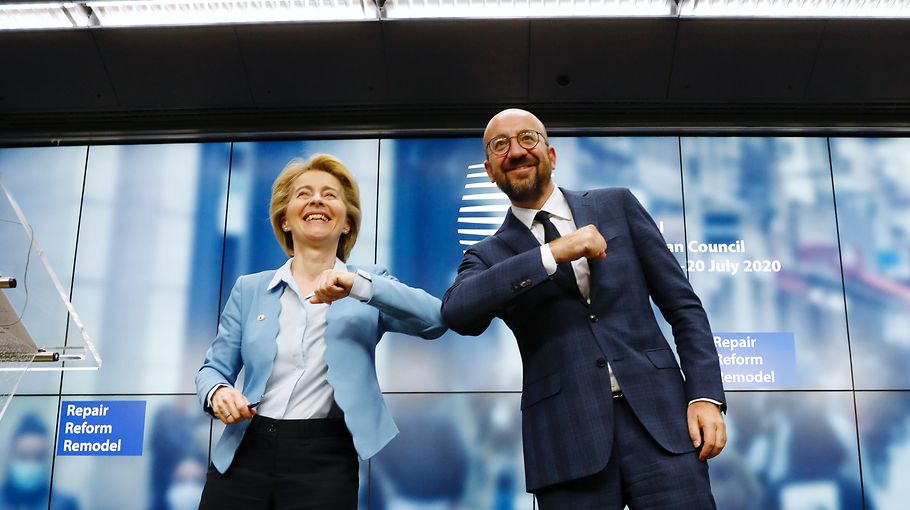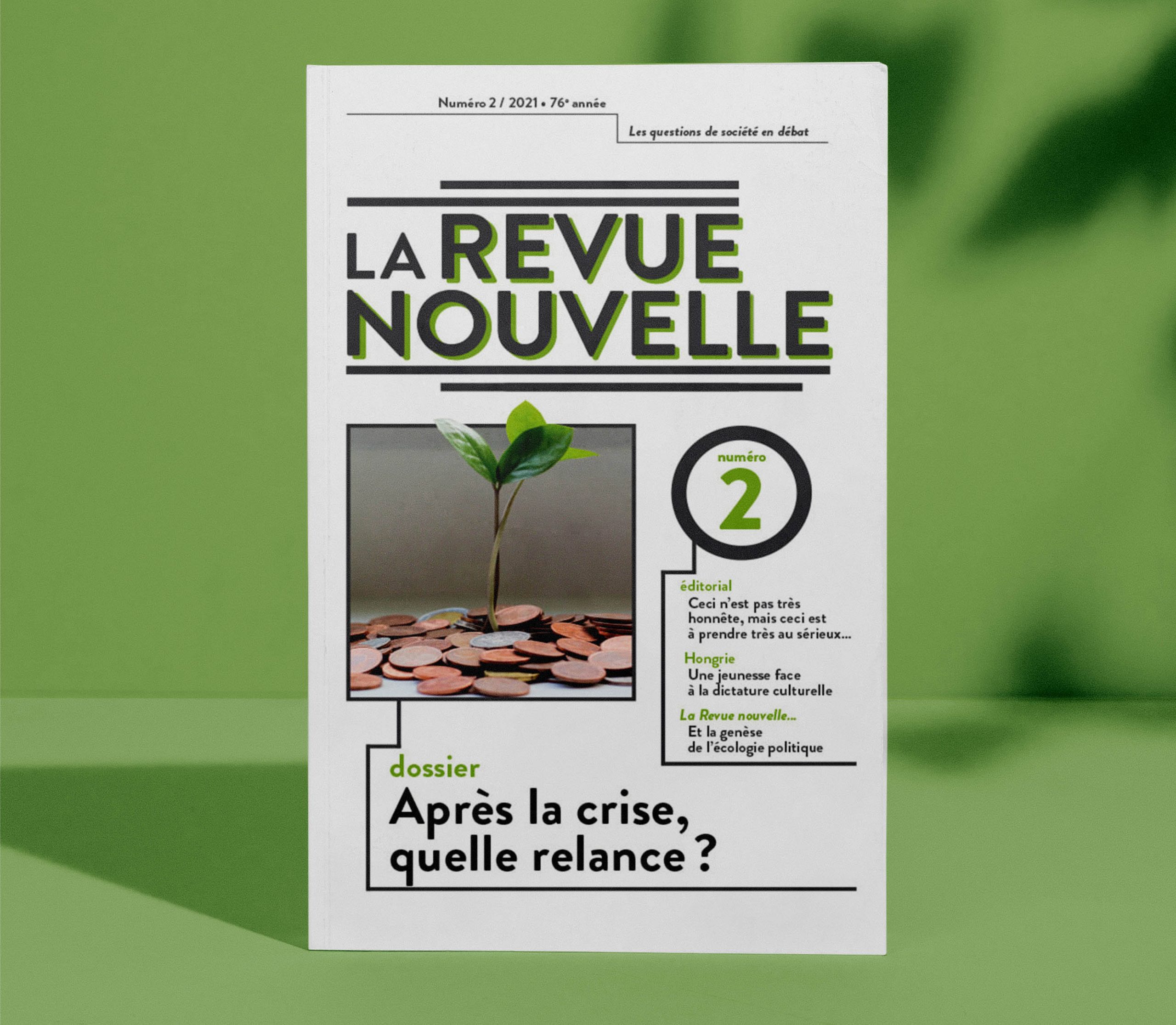After lengthy COVID-19 restrictions, economic recovery is at the top of many political agendas. The EU’s comeback strategy – a €750 billion grant and loan repayment scheme – heralds an anti-austerity, environmentally friendly vision. But how realistic is reform when employment legislation still tows a market-driven line? And what lasting ecological provisions can be made from such a rapid, goal-focused turnaround?
The COVID-19 pandemic and consequent public health measures have plunged the global economy into the worst crisis it has seen since the mid-twentieth century. Europe is no exception, with economic analyses from the European Commission showing a 6.4% fall in EU GDP in 2020.
In its handling of this crisis, economic health is not the only thing at stake for the EU, already weakened by Brexit and the increasing power of political forces hostile to its liberal-inspired project of political integration. It needs to demonstrate exemplary solidarity between member states and show that it can break free from the austerity-led policies used to handle previous crises, all without abandoning its main political objectives, including those announced as part of the European Green Deal.
A careful examination of each of these points reveals that, despite clear progress, the EU recovery strategy will not lead to a radical reshaping of the European project but, at best, will institutionalize a few modifications while reopening crucial debates about the future of the Union.
A minor Hamiltonian moment
Funding investment through the creation of a joint debt is a federalist method effectively used to cement the cohesion of political integration projects. In 1790 Alexander Hamilton foresaw that the creation of a federal debt would strengthen ties between the entities brought together to form the United States of America, while increasing the authority and legitimacy of the federal power, which would thereby become indispensable to the prosperity of all.
Will the agreement reached by the European Council on 21 July 2020 usher the EU into a federal era, characterized by greater supranationalism and resource sharing? Not necessarily.

European Commission President Ursula von der Leyen and Charles Michel, President of the European Council. Photo by German Presidency of the Council of the EU 2020 from Flickr
The European Council has come to an agreement on the EU budget for the next seven years, the multiannual financial framework for 2021–2027 and the €750 billion recovery plan. The latter, also called Next Generation EU, consists of €390 billion in grants and €360 billion in loans. It introduces a major new feature into the European architecture: the EU will borrow the sums required to fund national recovery plans on behalf of the twenty-seven member states and they will jointly repay these loans. This points to a future of increased solidarity, as member states will receive funds based on their needs and repay them depending on their financial capacities.
The sums involved are considerable. Bulgaria, for example, is set to receive the equivalent of nearly a quarter of its GDP from the European budget and the recovery plan by 2026. This facilitation of unprecedented transfers of financial resources marks a historic moment.
This joint debt has revived the crucial discussion concerning the Union’s own resources. There are three broad possible avenues for repayment of the European recovery plan: member states dig into their pockets and increase their contribution to the EU budget; the resources made available to joint programmes and initiatives are cut back; or new ways of raising funds are considered. While the first two options cannot be ruled out at this stage, it is the latter that has taken centre-stage following the agreement in July 2020 and the adoption of the roadmap for Own Resources by the European Parliament and Council in November 2020.
Plans initially include a tax on single-use plastics, a carbon border adjustment mechanism, a digital tax, and a levy on aviation and maritime transport through a revision of the EU Emissions Trading System. Other proposals are set to be put forward before the end of the current multiannual financial framework, including a financial transaction tax.
Any potential qualitative leap in terms of political integration will depend on these proposals, whose negotiations may well be epic given the stakes involved and the requirement for unanimity on tax legislation.
However, the federalist character of the EU recovery strategy cannot be taken for granted. The debate on the conditionality of the rule of law is the most telling demonstration that major differences persist regarding the foundations and objectives of the EU, at least within the European Council.[1]
Furthermore, joint debt is limited in size and time: the €750 billion must be repaid by 2058 at the latest. Member states are united by a fixed-term loan rather than eternal debt, on which Europeans might be happy to pay interest and accept ‘roll overs’.
The joint debt at the basis of the European recovery plan is underpinned by a solidarity measure that is entirely relative. Indeed, agreement was only achieved through lengthy discussions, in particular with so-called ‘frugal’ states (Austria, Denmark, the Netherlands, Sweden and Finland) that were against the mechanism. The European Council was only able to reach a consensus by granting rebates on contributions to the EU: Austria secured a €565 million rebate, Denmark €377 million, the Netherlands €2 billion (despite having the second largest trade surplus in the Eurozone after Germany) and Sweden €1.069 billion. The key instrument at the heart of the strategy is the Recovery and Resilience Facility (RRF), which will make €672.5 billion available in the form of loans (€360 billion) and grants (€312.5 billion) to support reforms and investment in member states. Member states have to present Recovery and Resilience Plans that provide a detailed description of their reform and investment plans; a point to which we will return. Here we merely note that of the €750 billion borrowed, only €77.5 billion has been assigned to the EU budget.
Most of the money on loan is earmarked for national plans, which will have to meet certain EU-wide requirements (see below), but which also epitomize to a large extent national priorities.[2]
The alternative might have been to dedicate a greater share of the €750 billion to funding European programmes and projects. However, the opposite has happened: to seal the deal on recovery and the EU budget, major cuts had to be made to the European Commission proposed joint EU programme allocation such as those funding research or supporting workers affected by restructuring.
The reduced amounts allocated to the current EU budget compared to previous periods (excluding transfers to the UK) also confirm that the sharing of financial resources may not be as popular in Europe as the recovery plan appears to suggest.
‘Reform’: The Trojan horse of austerity

This article first appeared in La Revue nouvelle 2/2021 as featured in the Eurozine Review 7/2021.
The EU recovery plan also has a Keynesian flavour, since its aims are to climb out of the crisis through investment and debt rather than cuts to public spending, pressure on wages and increased labour market flexibility – a major turning point from the methods used to recover from the 2008–2009 financial crisis. This change in direction has been largely illustrated by the activation of the Stability and Growth Pact’s general escape clause, which allows member states to break with austerity-led, procyclical budget rules, previously implemented in a draconian manner.[3]
The European Central Bank has also played a crucial role through its Pandemic Emergency Purchase Programme (PEPP), which helps maintain the credit capacity of banks and keeps interest rates at very low levels.
To mitigate the impact of the crisis on the labour market, the SURE (Support to mitigate unemployment risks in an emergency) mechanism is loaning €100 billion to furlough schemes, which has also been raised on capital markets for the EU. These measures reflect a desire to facilitate public spending and prevent the paralysis of principal economic agents while protecting workers from excessive loss of income – a stark contrast to the troika.
But the European recovery plan is written on more of a palimpsest than a blank page. Its Keynesian-inspired measures are grafted onto a macroeconomic governance framework whose foundations remain largely unchanged. The various drafts of the European recovery strategy all emphasize the need to make member state recovery plans conditional on the adoption of reforms.
The EC’s guidance document for member states provides several useful indications regarding the possible interpretation of the generic term ‘reform’, including: pension reform, labour market reform, reducing administrative and regulatory ‘red tape’ that hampers business competitiveness, and reducing labour taxation.
While some of the proposed reforms appear to be ‘functional’ in nature,[4] others are ‘political’, suggesting that austerity, has not entirely disappeared. The dominant macroeconomic frame of reference is still largely based on the dual objectives of reducing public spending and increasing labour market flexibility.
Regulation on the RRF also enables the implementation of measures that link the recovery plans to ‘sound economic governance’ (article 9) allowing the Council, on a proposal from the Commission, to suspend its support programmes. Checks will also be put in place to ensure that the exceptional sums made available to certain member states do not result in excessive spending or fraud.
The regulation also requires that national recovery plans are in line with the recommendations and reform plans developed as part of the European Semester, one of the key instruments of EU macroeconomic governance. The requirement for conformity with these country-specific recommendations, coupled with the impact on growth and job creation, is the most important of the Commission’s criteria for assessing the plans.
Spain provides a case in point. As one of the worst hit in the EU, with an almost 11% drop in GDP in 2020, the country is set to be one of the European recovery plan’s main beneficiaries (around €140 billion). The Spanish recovery plan includes many projects, most of which fall within the digital and renewable energy spheres.
Two reforms are still under discussion: the labour market and pensions. Both involve repealing legislation introduced by the Spanish conservative government in power in 2012, which would curb the labour market’s dualization and tackle the precarity experienced by a significant share of the population. Despite being key components of the centre-left government’s programme, these reforms are currently on hold, much to the chagrin of trade unions and satisfaction of employer organizations, primarily concerned with the health of public finances.
The 2020 European Semester recommendations for Spain do not specifically mention these two reforms; while it would be wrong to reduce the European Semester to an austerity-led diktat, particularly in view of its ability to identify social imbalances, the Spanish case clearly shows how a break with austerity cannot be taken for granted. The content of the various reform plans will be decisive and it is crucial that a balance of power enables progressive social and political forces that prevent austerity policies returning through the back door of reform.
At stake is the macroeconomic matrix of ‘what comes next’. Many questions remain unresolved, including the thorny issue of public finances placed under long-term strain by colossal debt and its corollaries – the future of the European Stability and Growth Pact and the mandate of the European Central Bank. The recovery strategy has not yet resulted in the institutionalization of an alternative economic paradigm. The foundations of the EU’s macroeconomic governance framework remain in place even if their application has been temporarily modified.
Green strategy-led technological acceleration

The Greenwash Guerillas
Photo by fotdmike from Flickr
The European recovery strategy is also assumed to be green. It should accelerate the momentum of the European Green Deal, which sets big targets, particularly in terms of reducing greenhouse gas (GHG) emissions by 55% by 2030 to reach climate neutrality by 2050. 30% of available funds (from the European budget and the RRF), including 37% of the RRF, have been allocated to fighting climate change. Provided they are appropriately employed, these funds could be a genuine financial turbo-charge for the European Green Deal. But they will not be enough to meet the 2030 emissions reduction targets alone, which, according to the European Commission, require an additional €438 billion annually.
RRF-funded projects mustn’t cause any significant environmental damage. The quantified spending targets and assessment procedures put in place must ensure consistency between the European recovery plan and the EU’s climate and environmental targets.
Here, there are grounds for tempering the enthusiasm some have shown for this ‘green’ recovery. First, there are questions about the ability of the procedures put in place to analyse in detail all the projects funded by the recovery plan, or even those funded by the RRF alone. The sums to be spent are so great, over such a relatively short period of time, that some observers fear significant problems with the absorption capacity of many countries already struggling to spend their allocated ‘standard’ cohesion funds. In this context, a systematic, in-depth assessment of the climate and environmental impact of funded projects may pose some practical problems.
Another risk, particularly for large member states that have adopted their own national recovery plan independently of European funds, is the temptation to use European funds for green projects that would have gone ahead anyway and to keep less ethical projects for the greyer area of national funding. This challenges the ‘additionality’ principle governing the allocation of European funds, which might be used to replace existing national funding. Double accounting is also a risk, particularly for co-funded projects.
Furthermore, while the assessment procedures set out eligibility criteria that exclude technologies with a significant impact on the environment, they still allow for a certain margin of appreciation. Thus, while using fossil fuels to produce electricity is considered incompatible with the ‘do no significant harm’ principle, some exceptions are made, in particular for coal-dependent regions.
The member states’ recovery plans are yet to be examined in detail. While many of the published national plans do emphasize activities such as energy-efficient building renovation, use of renewable energy sources, electric road transport and developing the clean hydrogen sector, they also feature several projects with unclear or clearly negative impact.
So far, the limitations of electrification as a decarbonization strategy haven’t been fully addressed. Certain issues remain unresolved: namely that electricity production is significantly carbon-based in Europe[5] and a sudden increase in electricity demand might result in prolonged operation or even the construction of polluting production plants.
It is therefore essential for the Green Deal to create the conditions of a recovery compatible with the constraints of climate change that accelerate decarbonization and curb energy consumption. If not, we will be chasing an illusion of green growth that is unachievable in the long term.
The green credentials of the recovery strategy must also be viewed in relation to its other objectives such as digitalization of the economy. Around 20% of RRF funds are to be spent on digitalization, without any questions being raised about synergies and possible tensions between this goal and environmental targets.

Cyber Security © Ramin Aryaie Photo via Das Progressive Zentrum
The terms ‘digital’ and ‘digitalization’ do not even appear in the Commission document that sets out the way in which the environmental impact of projects is to be assessed. However, this is a crucial issue. In a recent report, the French High Council on Climate identified the impact of the 5G roll-out, particularly on imported emissions and increased electricity consumption. Uncontrolled digitalization could put climate neutrality targets out of reach while creating other environmental problems such as difficult-to-recycle waste and the excessive consumption of materials.
The recovery strategy is not simply a technical instrument designed to solve an economic crisis. It reveals an image of Europe as a political project. Despite the scale of the resources involved, it is not a break with the past in terms of the nature of the European political project. It makes member states jointly indebted for the repayment of a loan but does not herald a new federal era for Europe. It temporarily curbs the neoliberal lines of its macroeconomic governance framework and accelerates certain technological transformations pursued in the name of reducing GHG emissions but does not lay the foundations for an economic model radically redefined with social and ecological sustainability at its core. Significant breaks with the past are still a battle.
[1] See Nicolas de Sadeleer, ‘La condition “État de droit”, un coup d’État institutionnel au niveau européen?’, L’Écho, 30 December 2020.
[2] This does not however preclude potential funding of joint projects chosen through the national recovery plans.
[3] The European Commission recently proposed continued activation of the Stability and Growth Pact safeguard clause until 2022; see ‘Commission Presents Updated Approach to Fiscal Policy Response to Coronavirus Pandemic,’ European Commission, 3 March 2021, https://cutt.ly/0zn7zhH.
[4] The accelerated roll-out of renewable energy, for example, may require regulatory adjustments to the operation of the transport and electricity distribution networks.
[5] According to Eurostat data, combustible fossil fuels provided 40% of the electricity produced by the EU 27 in 2018. See ‘EU Energy in Figures 2020’, Statistical Pocketbook 2020, p. 94.
The authors of this article wrote it in their own capacity and it only reflects their personal views.

Translated and edited by Cadenza Academic Translations.
Published 3 September 2021
Original in French
Translated by
Cadenza Academic Translations
First published by La Revue nouvelle (French version), Eurozine (English version)
Contributed by La Revue nouvelle © Benjamin Denis / François Sana / La Revue nouvelle / Eurozine
PDF/PRINTPublished in
In collaboration with
In focal points
Newsletter
Subscribe to know what’s worth thinking about.
Related Articles

Syria’s reinvigorated civil society must assert itself not just in negotiations with the new government, but also in its dealings with Europe. Neo-colonial assumptions regarding minorities and gender are a source of tension that Europe would do well to reflect on.

Ukraine faces its greatest diplomatic challenge yet, as the Trump administration succumbs to disinformation and blames them for the Russian aggression. How can they navigate the storm?






